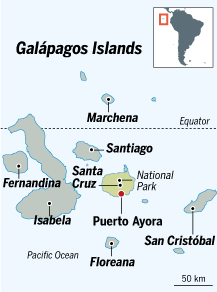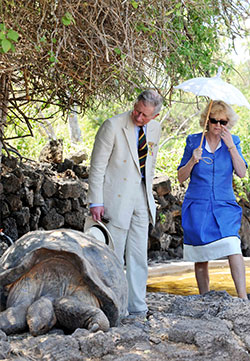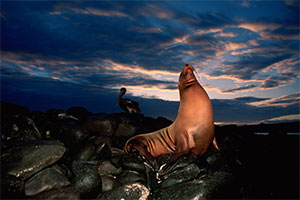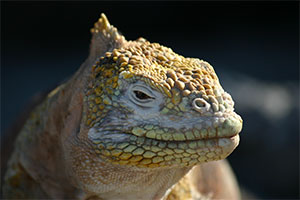Protecting paradise: The Prince of Wales’s work in the Galápagos

Simply sign up to the Life & Arts myFT Digest -- delivered directly to your inbox.
It was a typical afternoon on the Galápagos Islands when The Prince of Wales last toured the area five years ago: implacably hot and otherworldly, a place where everything conspires to make visitors feel at the end of the earth, or its beginning.
As The Prince walked through the lava fields, marine iguanas huddled in close groups by the surf, regarding a sea of the palest, most elusive green. Above them, red-bibbed frigatebirds swooped and tangled in the air. The aspect was prehistoric, conjuring up visions of a plesiosaur gambolling across the sand.
Yet although the islands appear otherworldly – Herman Melville said the “enchanted islands” looked like giant cinder heaps rising from the sea – they are also very much in this world, filled with the usual human concerns of need, greed and survival.

In an attempt to balance the age-old tension between economic development and environmental protection, The Prince’s Foundation for Building Community has, for the past four years, worked to draw up sustainable building codes and architectural plans for the local population of about 30,000 people.
“In the past 30 years, the population increased dramatically. The growth of towns and villages has often been unchecked and ad hoc, with a rising negative impact,” says Michael Romero, director of the foundation’s projects in the Americas.
“Our work has been to assist local communities and government to rationalise where and how this development happens.”

Conservation on the islands, which inspired Charles Darwin’s On the Origin of Species, has a chequered history. Most recently, in 2007, Unesco put the Galápagos on its list of world heritage sites in danger. In 2010, somewhat controversially, the organisation removed the warning after the Ecuadorean government, which governs the islands, tightened environmental rules.
Conservationists say the biggest threats to the islands’ flora and fauna are invasive species introduced by accident, although tourism is another strain. While the industry provides welcome revenue, more than 170,000 tourists visit every year (according to figures from 2012), almost four times the number 20 years ago.
Moreover, half of them visit by island hopping and stay at local hotels, which stretches water, food and energy provisions more than the higher-expense, yacht-based tours.
“Tourism, paradoxically, is the biggest provider of funds for conservation. So there is a self-perpetuating desire by Ecuador to maintain and preserve the islands because that generates more income,” says Ian Dunn, chief executive of the UK-based Galápagos Conservation Trust, which co-funds the foundation’s work.

“As tourism increases, though, so do the demands placed on locals by tourists, especially for water and energy. The question then becomes: how to best provide those resources, and house the native population?”
Initially, The Prince’s Foundation for Building Community was called in to design building codes for El Mirador, a state-approved suburb of 1,133 houses outside Puerto Ayora, where two-thirds of the island population live, often in the same grimy and ecologically unfriendly breeze-block and corrugated tin-roof architecture.
The codes focused on creating sustainable buildings and a sustainable community by addressing issues of urbanism, architecture and landscape with an ecological approach.

“Calling in The Prince’s Foundation was a pragmatic response. If the population is growing – despite the stricter migration controls – you need to have suitable environmental housing for them too,” says Dominic Hamilton of Metropolitan Touring, an agency based in Ecuador’s capital Quito that runs island tours.
The ideas are mostly simple. Recycle water. Use renewable building materials, if possible, and natural ventilation to minimise air-conditioning run from power generated by imported diesel fuel. Lastly, allow for more cycle paths – as cars run over 13,000 birds a year – and educate and engage with the local population. “There is a fairly young population on the islands, so we want to ensure we reach out to the next generation to make them aware of how their decisions can impact the islands’ future,” says Romero.

One problem is that 52 per cent of the islanders are classified as “poor”, according to government figures from 2010, and are locked in their own Darwinian battle for survival and tourists’ dollars, all of which feeds an inferno of small-town jealousies and competition. Other problems include the embedded interests and supply chains that provide traditional building materials.
Last year, Rafael Correa, Ecuador’s president, warned that the islands faced “multiple problems” from “disorder, a lot of abuse, a lot of anarchy, lack of policies”. To improve matters, he appointed an outsider as governor of the islands, Maria Isabel Salvador – a former ambassador – and elevated her post to ministerial level.

“We are moving well, but it’s not an overnight process,” says Dunn.
As for The Prince’s Foundation for Building Community, which has four people working on the Galápagos, it consulted with locals to draw up new building codes for Isabela Island, which has the archipelago’s third biggest population. It also advised national park authorities and the Charles Darwin Research Station on how to use more shade to ease heat and cut the need for air conditioning.
So far, however, it has been unable to build a model home planned for El Mirador as the plots belong to people over whom it has no influence. Even on the Galápagos, as in the rest of the world, when it comes to conservation, little is as easy as it may seem.
John Paul Rathbone is the FT’s Latin America editor
Comments